The quintessential guide on customer satisfaction: What, Why and how
Read More
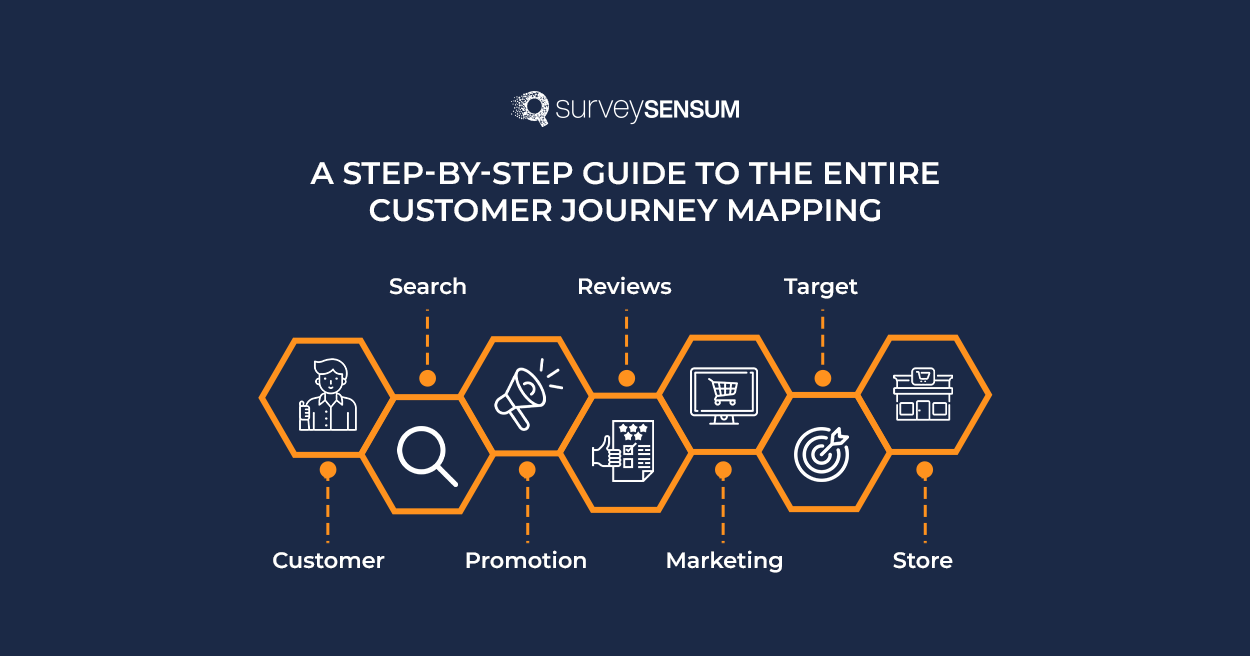
Have you ever considered the intricate process behind a customer’s decision to make a purchase?
This is where tracking the customer journey becomes crucial.
The customer journey includes everything from the awareness of the product to the action of purchasing, encountering multiple touchpoints that customers go through with your brand.
A customer feedback platform can help you map your entire customer journey. By doing that, you can gain valuable insights into following key questions:
With the answers to all these questions, you can understand your customers’ persona leading to boosting your sales and increasing customer loyalty and satisfaction.
So, are you mapping your customers’ journey aptly?
If not, then it’s high time to do so because it has the high potential to turn a stranger into a loyal customer.
So, let’s delve deeper into understanding what the customer journey entails and how businesses can leverage it effectively.
Importance of Customer Journey
Stages of the Customer Journey
What is Customer Journey Mapping?
Steps to Design Customer Journey Map
A customer journey is a set of various touchpoints that your customer goes through with your product, service, or brand before completing their purchase.
What we mean by various touchpoints is that before purchasing any product, they become aware of your business first, and if they like it, then they start considering your product, followed by the decision to buy it. This journey continues.
With customer journey, you can focus on how your customers behave after each interaction with your business. Also, the purpose of looking at the journey is to
For example, Amazon, an e-commerce brand, is known for its customer-centric approach. It has built its entire business around providing a seamless and personalized shopping experience. Here’s how it focuses on customers and maps their entire journey:
- Amazon offers a user-friendly website and mobile app with a vast product selection.
- It has streamlined the purchasing process with features like one-click ordering, saved payment methods, and fast checkout.
- Customers can easily track their orders in real-time. Real-time updates, shipment notifications, and estimated delivery times provide transparency and keep customers informed about their purchase’s progress.
- It offers various customer support channels, including live chat, phone support, and email assistance.
- It has a hassle-free return policy, making it easy for customers to initiate returns and receive refunds or replacements.
- It leverages customer data to offer personalized product recommendations, emails, and targeted advertising.
- It rewards customer loyalty through programs like Amazon Prime, which offers benefits like free shipping, exclusive deals, and access to streaming services.
- It continuously gathers customer feedback and analyzes data to enhance its services.
By focusing on the customer journey from start to finish and incorporating feedback and data-driven insights, Amazon strives to deliver exceptional customer experiences. They actively listen to customer suggestions, address pain points, and innovate to meet evolving customer needs.
So, define your customer journey to gather insights about their entire buying experience.
— You can improve your product and services to enhance your customer experience.
And by offering a seamless customer experience, you can foster loyalty, leading to an increase in customer retention and word-of-mouth referrals.
According to Forbes, 69% of U.S. consumers shop more with brands that offer consistent experiences in-store and online.
Before going further, let’s have a glance at the importance of the customer journey.
With customer journey, you can understand, improve, and personalize every customer interaction to boost their satisfaction and loyalty.
And you can also create a successful customer journey map that will give you a real insight into
So to know what your customers expect from you, you have to be aware of all the touchpoints.
That brings us to the stages in the customer journey.
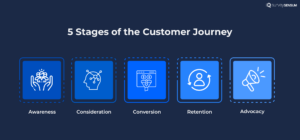
Here’re the 5 common stages that can help you to monitor the customers’ experiences across the journey.
The first three stages are of utmost crucial because they can either bring your customers to your business or not. The other two stages explore brand touchpoints with your online customers.
So, keeping these 5 stages in mind, let’s begin with stage one.

The awareness touchpoint is the first stage in the customer journey that refers to the initial point of contact between the customer and the business. At this stage, customers become aware of your brand, realize their pain points, and then look for a resolution.
Your customer will actively search online using Google, read informative posts, watch educational videos, and more to find the right solution for their problem. Or even talk to people around, take their advice, referrals, and experiences into consideration.
Now, this is the time for you to shine by making your business already available.
So, leverage this stage, build trust, create rapport, and arrive at a consensus with them by fulfilling their requirements.

Once the customers have some awareness about the product, they will soon begin considering your business.
So, it is crucial to provide relevant and compelling information about your product or service.
Here are some key actions to take:
By implementing these strategies, you can effectively guide customers through the consideration stage, helping them make informed decisions that ultimately lead to a purchase.
This brings us to the third stage – Conversion.

This is the stage where the customer decides whether to make a purchase or not.
In the prior two stages, your customers researched and considered a few options for a product that can resolve their pain point, right?
This stage is the fruit of the prior stages. How?
Because if your brand has passed the prior stages, there is a high chance of customers stumbling on your product.
At this stage of the customer journey, encourage the customer to make a purchase or take the desired action.
Here’s how you can do it –
That being said, here comes the retention at stage number four.

Your customer has now purchased the product, and you’ve given them an excellent onboarding experience, but how will you make sure that they keep using your product or bring them back for repurchasing?
To ensure your customers continue using your product and services, you can offer them
By implementing these points, you can retain your customers successfully.
A combined study by Bain & Co. along with Earl Sasser of the Harvard Business School, found that improving customer retention by a mere 5% can have an overall 25% to 95% increase in profits.
So, go beyond gathering customer feedback, act upon them, and prove that you actually care and value your customers.
Map Customer Journey With SurveySensum!
And finally comes the last stage – Advocacy.
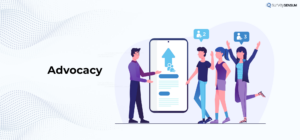
In this stage, the focus is on turning satisfied customers into loyal advocates who actively promote your brand and recommend it to others.
To achieve the best results at this stage, you can
So, implement this zero-dollar advertising as soon as you can.
Create your first Customer Journey with SurveySensum!
Now after knowing all the customer journey stages, are you ready to learn what customer journey mapping is and dive into the steps to design a customer journey map?
Let’s go.
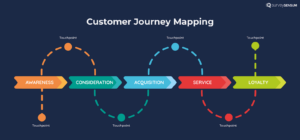
A customer journey mapping is a visual representation of what your customer has gone through while reaching your business. This includes all the touchpoints in chronological order to keep track.
It is not only limited to the interactions, but it also includes the sentiments of the customer felt by them during the journey at each touch point.
Let’s discover the steps to design a customer journey map.
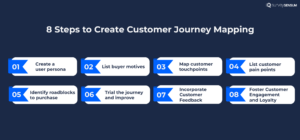
Here are 8 steps to create a customer journey map that works perfectly with your customer journey.
A user persona is a fictional depiction of your ideal customer, their age, gender, online and offline activities, common pain areas, spending habits, and so on. The user persona is what sets the direction toward creating the complete customer journey.
What are the motives that trigger the customer to make a purchase?
Is it a leisurely purchase or a necessity?
Depending on the motive, the customer journey can be personalized, elongated or shortened, interactive or reactive.
Here are some questions that can help you in creating the right customer journey:
By mapping customer touchpoints, you can know how customers engage with your brand. After understanding their behavior at each touchpoint, you can make informed decisions to improve those interactions and deliver a seamless and satisfying experience.
What pain points are the customers facing?
What kind of solutions are they expecting?
Is it a single fix like a product or a service that gets things done over a period of time?
Depending on the pain points, the customer journey can be designed for quick discoverability or for gradual lead nurturing.
From awareness until the decision stage, what kind of roadblocks do customers face?
Identifying these roadblocks will enable the business to craft a customer journey that bypasses them as well as accelerates the customer from awareness to decision and beyond.
Like all things that get better with time and improvisations, even customer journeys can be improved with continuous testing and improvements.
There is no get-it-right first time.
Constant testing, analyzing, and even gathering customer inputs is what is going to deliver a better journey.
Here’s a customer journey mapping template that you can refer to or use.
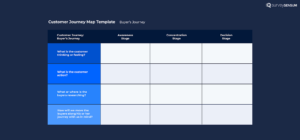
Incorporating customer feedback while creating customer journeys is crucial as it gives valuable insights into customer experience at different stages in their entire customer journey. You can deploy any kind of customer feedback survey, be it NPS, CES, or CSAT, to understand your customer better and map the customer journey effectively.
Here’s how you can incorporate customer feedback at each stage of the customer journey mapping process:
By fostering customer engagement and loyalty in customer journey mapping, you will be able to emphasize the importance of nurturing customer relationships and fostering long-term loyalty.
Follow these few points to incorporate customer engagement and loyalty:
You’ve made it this far, so let’s rapidly look at what methods are there through which you can map the entire customer journey.
By now, you must have understood that the customer journey is a stage-by-stage process as multiple thoughts go on into creating a customer journey.
So, here are some of the methods that you can use to create the right customer journey:
If you are running an online store or have a website that is generating most of the leads, the best way to begin designing a customer journey is with the website’s behavior.
There are heatmap tools that show where the user spends most of the time, what buttons or links they click on, and how deep into the web page they scroll to obtain information. Armed with such data, you can easily craft a customer journey that will maximize your conversions.
In-store user behavior is also similar to website behavior. The difference is that users scroll through websites while they stroll in the store. They follow a specific route in the store in discovering and adding goods to their shopping carts.
Retail stores like IKEA have already recognized the fact that designing an in-store planogram that reflects user behavior and expectations can take sales through the roof. If planned wisely, it can even make the customer shop for items that they never intended to buy.
There is nothing that beats the good old market research when it comes to creating a customer journey. It should be the first go-to method for businesses that are crafting their first customer journey.
Market research for the customer journey can be done in two ways:
These are the most common methods one can deploy to create a customer journey.
The customer journey includes various stages through which a customer passes before they decide to make a purchase. At each stage of the journey, they undergo thorough research to understand resolutions given by multiple brands, leading to fluctuations in their expectations and doubts that the business has to answer.
Positioning the right marketing collateral can help smoothen the customer journey and improve the overall conversion rates.
A customer journey is not a haphazard route but rather a detailed plan that sketches what a customer could be doing and would be wanting at each stage.
There are several methods of customer journey mapping that help create the right collateral for each stage. If done right, it could even make customers spend more than what they had initially planned to purchase.
Ready to enhance your customer journey?
Explore Surveysensum today and discover how it can help you enhance your customer experiences and boost satisfaction.
